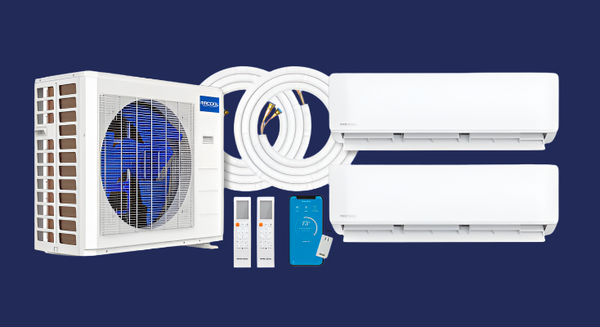What Is an HVAC System? A Complete Guide to Choosing the Right One for Your Home
Understand heating, ventilation, and air conditioning like a pro. This guide explains HVAC system types, pros & cons, selection criteria, and why DIY-friendly MRCOOL systems deliver smart, efficient comfort with lower installed cost.
Shop MRCOOL 5th Gen DIY Mini-Splits Hybrid Builder & BTU Calculator
What Is an HVAC System?
HVAC stands for Heating, Ventilation, and Air Conditioning—the equipment that controls temperature, humidity, airflow, and air quality in your home.
- Heating: Furnaces (gas/electric) or heat pumps provide winter warmth.
- Ventilation: Ductwork, filters, and fresh-air strategies remove contaminants and balance indoor air quality.
- Air Conditioning: Central AC or ductless mini-split systems deliver summer cooling.
Types of HVAC Systems & Which One Fits Your Home
1) Central Split HVAC (Furnace + AC or Heat Pump)
Best for: Larger homes with existing ductwork that want whole-home, single-thermostat control.
- Pros: Even temperature in every room; integrates filtration, humidification, and fresh-air kits; one thermostat.
- Cons: Higher installed cost; duct sealing/cleaning required; zoning add-ons can be pricey.
2) Ductless Mini-Split (Single-Zone or Multi-Zone)
Best for: Homes without ducts, additions, garages, bonus rooms, or room-by-room zoned comfort.
- Pros: High SEER2 efficiency, quiet operation, zoned temperature control, easy retrofit.
- Cons: Multiple indoor units may be needed in open plans; wall or ceiling cassette placement required.
3) Heat Pumps (Air-Source)
Best for: Moderate climates; with cold-climate models, effective in low outdoor temps.
- Pros: Heats and cools with one system; great energy savings; pairs with electric or gas backup.
- Cons: In very cold regions, may require auxiliary heat or dual-fuel configuration.
4) Packaged HVAC Units
Best for: Small homes or where indoor equipment space is limited.
- Pros: All-in-one outdoor cabinet; fast service access; simplified install.
- Cons: Less customizable than split systems; service exposure to weather.
| System Type | Great For | Efficiency Notes | Install Complexity |
|---|---|---|---|
| Central Split | Whole-home with ducts | SEER2 (cooling), AFUE (furnace), HSPF2 (heat pump) | DIY or Pro install; duct design matters |
| Ductless Mini-Split | Rooms/zones, no ducts | Very high SEER2; excellent part-load efficiency | DIY-Friendly (MRCOOL Quick Connect) |
| Heat Pump | Most climates; dual-fuel in cold regions | HSPF2 & SEER2; inverter = top savings | DIY or Pro Install Moderate to advanced |
| Packaged Unit | Space-limited installs | Good; less flexible than split | DIY or Pro install; easy service |
How to Choose the Right HVAC System
- Evaluate load and size: Use Manual-J principles or try our MRCOOL BTU calculator for finding the perfect system size.
- Consider energy efficiency: High SEER2 (cooling) and HSPF2/AFUE (heating) reduce utility costs.
- Match climate: Heat pumps excel in moderate climates; furnaces/dual-fuel in very cold regions.
- Set your budget: Factor installed cost + long-term energy savings.
- Think zoning: For personalized comfort, choose MRCOOL multi-zone DIY mini-split systems for whole-home zoned comfort.
Why DIY HVAC Systems Like MRCOOL Are a Smart Choice
- Pre-charged Quick Connect® line sets: True DIY—no vacuum pump or gauges required.
- Inverter technology: Whisper-quiet, variable-speed comfort with lower kWh usage.
- Smart app control: Scheduling, geofencing, and voice assistants for automation.
- Lower installed cost: Save thousands vs traditional installs without sacrificing performance.
Start here: shop MRCOOL DIY mini-split systems for every home size or explore hybrid mini-split with central ducted options for mixed spaces.
Explore HVAC Solutions by Application
HVAC FAQs
Is a ductless mini-split better than central air?
What SEER2 rating should I choose?
Can I install a MRCOOL DIY system myself?
What’s the difference between a heat pump and a furnace?
Ready to Choose the Right HVAC System?
Shop All MRCOOL Mini-Splits Hybrid Mini-Split + Central Ducted Builder Explore Dual-Fuel Systems
Need help? Our experts can guide you to the best HVAC system for your home based on size, climate, and budget.




